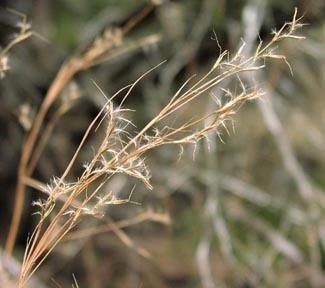Birchleaf Mountain Mahogany

Common Name(s):
Little Bluestem
Scientific Name:
Schizachyrium scoparium (Michaux.) Nash
Scientific Name Synonyms:
Symbol:
SCSC
Description:
Life Span: Perennial
Origin: Native
Season: Warm
Growth Characteristics: Little bluestem is an occasionally rhizomatous bunchgrass that is 12-24” tall. It begins growth in late spring and continues growth until the first killing frost. Stems are coarse and erect, and leaves grow from the base. It has very flat bluish basal shoots. Plants are green to bluish, but turn to a reddish color after frost.
Seedhead: The seedheads are racemes that are 1-2” long, located at the tips of the stems and its branches. The rachis and spikelet pedicels (stems) are very hairy with white spreading hairs. Its glumes are firm and lemmas of the upper florets have bent, twisted awns 1/4 - 5/8” long.
Leaves: Leaf blades are at least ¼” wide, are flat and smooth but may be covered with hair at the base next to the sheath. Blades tend to fold at maturity. Leaves have very small ligules.
Ecological Adaptions:
Little bluestem occurs along waterways, in rock crevices, and in desert shrub, pinyon-juniper, ponderosa pine, and hanging garden communities of Southern Utah at elevations below 7,500’ where annual precipitation is less than 10”. It is drought tolerant.
Soils: It is adapted to well-drained, sandy, infertile soils that are neutral to slightly alkaline.
Associated Species: Associated species include littleleaf mountain mahogany, big sagebrush, Utah serviceberry, roundleaf buffaloberry, pinyon, juniper, ponderosa pine, cliffrose, and skunkbush sumac.
Uses and Management:
Little bluestem occurs throughout the U.S. and is consider to be only fair forage for grazing animals. It is commonly used in revegetation where soil conditions vary widely. It provides food and cover for birds and is also used in landscaping.

